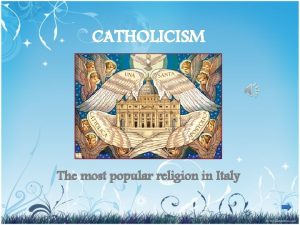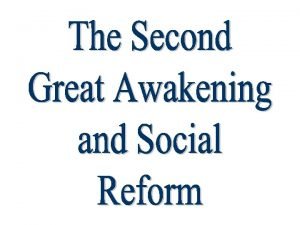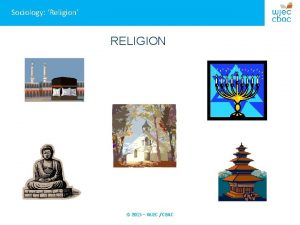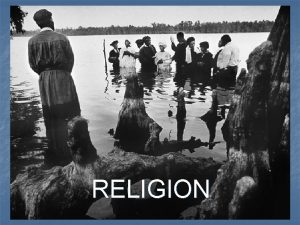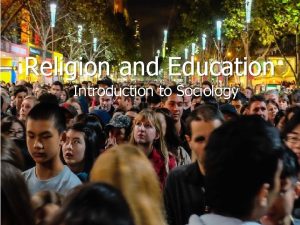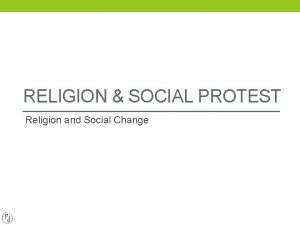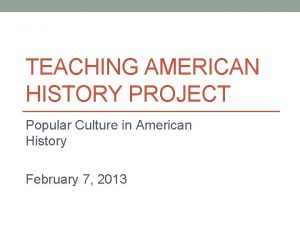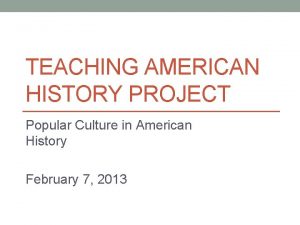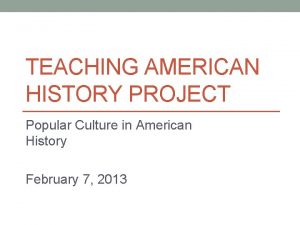The Rise of Popular Religion American religion had





















![The Second Great Awakening “Spiritual Reform From Within” [Religious Revivalism] Social Reforms & Redefining The Second Great Awakening “Spiritual Reform From Within” [Religious Revivalism] Social Reforms & Redefining](https://slidetodoc.com/presentation_image_h2/4ec13bbb9c6601570b5c453608b387e8/image-22.jpg)





















- Slides: 43


The Rise of Popular Religion American religion had changed greatly since the preaching of Jonathan Edwards, and others during the Great Awakening of the 1730’s and 1740’s.

The Rise of Popular Religion Many of the Founding Fathers supported Deism relying on reason, rather than faith and science; rather than the Christian Bible. They did believe in a supreme creator, but not in the divinity of Jesus Christ.

The Rise of Popular Religion Deism gave birth to the Unitarian movement which gained popularity around the turn of the 19 th Century. Unitarians believed in one creator, stressed the goodness of mankind, and believed in eternal salvation through good works.

The Rise of Popular Religion Around 1800 hard core, conservative Puritanism began to spread with renewed vigor in the face of these more liberal beliefs.

This Second Great Awakening swept the nation bringing thousands back to organized Christian religion in an effort to combat the “evils” of society.

The message was spread to the West through traveling preachers, new churches, and mass revivals attended by 10, 000 to 20, 000 souls.

New York was touched by so much of this heated revival it came to be known as the “Burned Over District. ” New Churches formed, old churches split, and revivalist preachers spread a new message of societal reform.

Charles G. Finney Peter Cartwright

This time of revival resulted in even more religious diversity than before.

One of those most influenced by this time of religious revival was Joseph Smith, who believed he had been contacted by angles who revealed to him the secrets that would become the basis for the Mormon faith.

For a variety of reasons, Smith and his followers were not welcomed in several areas in which they attempted to settle. Smith himself was killed in Illinois.

Leadership of the Church of Jesus Christ of Latter-Day Saints fell to Brigham Young who, in 1846 -1847 led the Mormons on a trek to their own settlement far removed from the rest of America.

Young established the “state” of Deseret which was ruled by the teachings of the Church. The Mormons would run into conflict with the U. S. government following the Mexican American War.

Religious diversity was only one of the changes the Second Great Awakening brought to American society.

Preachers like Finney and Cartwright began to change the message of Christianity. Old Calvinist ideas of predestination were swept away.

People began to believe that God had not, in fact, pre-determined people’s eternal fate. As such, actions that people took in their daily lives might have an impact on what happened to their souls in the afterlife.

Finney, Cartwright, and others encouraged people to examine their lives and purge themselves of all sinful activity. As a result, much of the time that people spent at revival meetings was spent reading the Bible and reflecting on the sinfulness of ones life.

If a person lived a moral life, God might smile upon them and welcome them into Heaven. If they did not, God would likely damn them to eternal suffering.

More importantly, if people took actions to improve, not only their own lives, but also the world around them, God would certainly look upon these people with favor. As a result, the Second Great Awakening gave birth to a host of societal reform movements.

Many of these movement attempted to both reform American society, and expand the meaning of equality in the United States.
![The Second Great Awakening Spiritual Reform From Within Religious Revivalism Social Reforms Redefining The Second Great Awakening “Spiritual Reform From Within” [Religious Revivalism] Social Reforms & Redefining](https://slidetodoc.com/presentation_image_h2/4ec13bbb9c6601570b5c453608b387e8/image-22.jpg)
The Second Great Awakening “Spiritual Reform From Within” [Religious Revivalism] Social Reforms & Redefining the Ideal of Equality Temperance Asylum & Penal Reform Women’s Rights Abolition Education

The Temperance Movement Frances Willard The Beecher Family

To many Americans “Demon Rum” posed a threat to society and was an evil influence that needed to be removed. To that end they formed civic groups like the American Temperance Society in 1826.

Heavy drinking, they argued, decreased the efficiency of labor, made drunk more workers more prone to accident, increased domestic abuse, and cost families money they might otherwise have spent on food, clothing etc.

“The Temperance Home”

“The Drunkard’s Home”

Temperance movements took one of two possible paths: 1. Encouraging people to “reform themselves” and give up the bottle. 2. Encourage governments to make alcohol illegal.

While they couldn’t get the national or state governments to outlaw liquor, temperance advocates made significant gains in reducing the effects of “Demon Rum” on society.

Penitentiary Reform Women like Dorthea Dix turned their attention to the conditions of America’s prisons and Asylums. Appalled by the conditions that she found, she advocated for reform, especially for the mentally and physically challenged and the insane.

Women in the early 19 th Century: 1. Unable to vote. 2. Legal status of a minor. 3. Single could own her own property. 4. Married no control over her property or her children. 5. Could not initiate divorce. 6. Couldn’t make wills, sign a contract, or bring suit in court without her husband’s permission. 7. Cult of Domesticity

The 2 nd Great Awakening inspired women to improve society. Cult of Domesticity = Slavery Angelina Grimké R 2 -9 Sarah Grimké Lucy Stone American Women’s Suffrage Assoc.

Susan B. Anthony Lucretia Mott Elizabeth Cady Stanton

Women increasingly pushed for equal social and political rights, most famously at a meeting in Seneca Falls, New York in 1848. There they produced a “Declaration of Rights” asserting that “all men and women are created equal. ”

While the goal of voting rights was not achieved, women did make strides in the 1840’s and 1850’s in increasing opportunities both at home and away.

Educational Reform Religious Training Secular Education MA always on the forefront of public educational reform * 1 st state to establish tax support for local public schools. By 1860 every state offered free public education to whites. * US had one of the highest literacy rates.

Horace Mann (1796 -1859) “Father of American Education” Children were clay in the hands of teachers and school officials. Children should be “molded” into a state of perfection. Discouraged corporal punishment R 3 -6 Established state teachertraining programs.

The Mc. Guffey Eclectic Readers Used religious parables to teach “American values. ” Teach middle class morality and respect for order. Teach “ 3 Rs” + “Protestant ethic” (frugality, hard work, sobriety)

Women Educators Troy, NY Female Seminary curriculum: math, physics, history, geography. train female teachers Emma Willard (1787 -1870) 1837 she established Mt. Holyoke [So. Hadley, MA] as the first college for women. Mary Lyons (1797 -1849)

All of these movements found support. However, they all grew increasingly overshadowed and lost support to the most influential of the bunch. Temperance Asylum & Penal Reform Women’s Rights Education

Abolitionist Movement For many, the largest “sin” in America was the continued presence of slavery.

The abolitionist movement rapidly overshadowed the others as the nation began to tear itself apart over the issue of slavery in the United States.

 Little lambs academy
Little lambs academy A union b example
A union b example Rise and rise until lambs become lions
Rise and rise until lambs become lions Tricky dick: the rise and fall and rise of richard m. nixon
Tricky dick: the rise and fall and rise of richard m. nixon Most popular religion
Most popular religion Most common religion in italy
Most common religion in italy If you had eaten a good breakfast
If you had eaten a good breakfast I have breakfast before i went to school
I have breakfast before i went to school Secneer
Secneer Thế nào là hệ số cao nhất
Thế nào là hệ số cao nhất Sơ đồ cơ thể người
Sơ đồ cơ thể người Tư thế ngồi viết
Tư thế ngồi viết Cái miệng xinh xinh thế chỉ nói điều hay thôi
Cái miệng xinh xinh thế chỉ nói điều hay thôi Hình ảnh bộ gõ cơ thể búng tay
Hình ảnh bộ gõ cơ thể búng tay đặc điểm cơ thể của người tối cổ
đặc điểm cơ thể của người tối cổ Cách giải mật thư tọa độ
Cách giải mật thư tọa độ Tư thế ngồi viết
Tư thế ngồi viết ưu thế lai là gì
ưu thế lai là gì Voi kéo gỗ như thế nào
Voi kéo gỗ như thế nào Thẻ vin
Thẻ vin Thơ thất ngôn tứ tuyệt đường luật
Thơ thất ngôn tứ tuyệt đường luật Các châu lục và đại dương trên thế giới
Các châu lục và đại dương trên thế giới Từ ngữ thể hiện lòng nhân hậu
Từ ngữ thể hiện lòng nhân hậu Diễn thế sinh thái là
Diễn thế sinh thái là V cc cc
V cc cc Vẽ hình chiếu vuông góc của vật thể sau
Vẽ hình chiếu vuông góc của vật thể sau Slidetodoc
Slidetodoc 101012 bằng
101012 bằng Chúa yêu trần thế
Chúa yêu trần thế Khi nào hổ mẹ dạy hổ con săn mồi
Khi nào hổ mẹ dạy hổ con săn mồi Lời thề hippocrates
Lời thề hippocrates Tư thế worms-breton
Tư thế worms-breton đại từ thay thế
đại từ thay thế Quá trình desamine hóa có thể tạo ra
Quá trình desamine hóa có thể tạo ra Công thức tính thế năng
Công thức tính thế năng Thế nào là mạng điện lắp đặt kiểu nổi
Thế nào là mạng điện lắp đặt kiểu nổi Dạng đột biến một nhiễm là
Dạng đột biến một nhiễm là Bổ thể
Bổ thể Vẽ hình chiếu đứng bằng cạnh của vật thể
Vẽ hình chiếu đứng bằng cạnh của vật thể độ dài liên kết
độ dài liên kết Môn thể thao bắt đầu bằng từ đua
Môn thể thao bắt đầu bằng từ đua Khi nào hổ mẹ dạy hổ con săn mồi
Khi nào hổ mẹ dạy hổ con săn mồi Thiếu nhi thế giới liên hoan
Thiếu nhi thế giới liên hoan điện thế nghỉ
điện thế nghỉ





